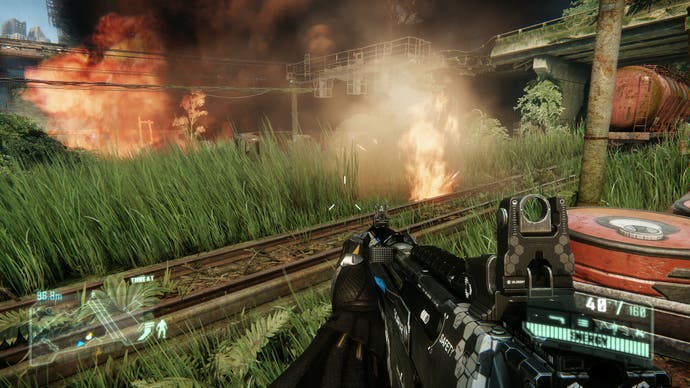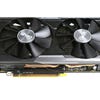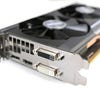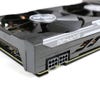AMD Radeon R9 380X review
The fastest ?200 graphics card on the market.
In performance terms, there's a big gap between the mid-range and high-end graphics cards on the market. GTX 970 is a substantial leap over its GTX 960 stablemate, while the Radeon R9 390 is also far more capable than the R9 380. There's room in the market for an 'inbetweener' - a keenly priced newcomer that can sit comfortably at the £200/$230 area in the market. AMD has got there first with the R9 380X and it's a fascinating product.
In effect, it's an unlocked version of the existing R9 380, based on the Antigua processor previously known as Tonga when it debuted in 2014's Radeon R9 285. The differences are straightforward enough - the 1792 shaders in the standard R9 380 are augmented with an additional 256 cores, opening up the full 2048 complement. Texture units also see an increase from 112 to 128. In theory at least, that's an additional 15 per cent of processor power assuming like-for-like clocks.
The card also ships with 4GB of GDDR5 RAM as standard, with no 2GB option. Memory consumption in gaming is only moving in one direction, and the R9 380 in particular has struggled in certain titles. At both 1080p and 1440p, 4GB of video RAM has proved sufficient thus far in containing almost every game we've tested at max settings. However, looking at chip photography of the Antigua chip, there is evidence to suggest that it has a 384-bit memory bus, suggesting it may have been originally designed for 3GB/6GB configurations. Assuming that's true, we're not surprised that AMD stuck with a 256-bit interface here - 3GB would be too little for a product in this price-range, while 6GB would have been complete overkill.
The card we're testing here is something of a gem. It's Sapphire's Radeon R9 380X Nitro, a beautifully designed card. Build quality is superb - it's a solid construction with a quality fans, quiet operation, and a brushed finish backplate. It's on par or better than the Asus Strix R9 380 we looked at a while back. Inputs and outputs are standard - there are dual DVIs (one with analogue support), DisplayPort and HDMI 1.4. Power is supplied via two six-pin PCIe inputs.
Sapphire's confidence in its construction here extends to a fairly meaty factory overclock. The R9 380X has a stock speed of 970MHz, while the Nitro card runs at 1040MHz. Memory also gets an overclock of its own from 5.5gbps to 6.0gbps. On top of that, our review sample is the most overclockable Tonga/Antigua-based card we've had in for testing. It required us increasing fan speed, but we hit 1150MHz on the core with 6.5gbps of memory bandwidth. This is rather impressive.
Order the graphics cards tested here from Amazon with free shipping:
- AMD Radeon R9 380X 4GB
- AMD Radeon R9 380 4GB
- AMD Radeon R9 380 2GB
- GeForce GTX 960 2GB
- GeForce GTX 960 4GB
And our advice is that if you're going to buy a Radeon R9 380X, getting a model as good as this one is a very good idea - because as you'll note from the benchmarks below, the reality is that the card isn't actually that much faster than the existing R9 380 running at stock frequencies, even with the meaty factory overclock in place.
Our tests begin at 1080p resolution - by far the most popular gaming resolution, according to the Steam hardware survey, and the best target for the R9 380X's capabilities. Up against the Gigabyte GTX 960 4GB we tested, the 380X shows a substantial improvement - even managing to post improvements above the 20 per cent threshold in truly demanding titles like Crysis 3 and Assassin's Creed Unity. Even Battlefield 4 - a game that Nvidia spent a lot of time and resource optimising - sees a nine per cent improvement on the R9 380X.
The boost is less pronounced compared to the existing R9 380 though, coming in at around 10 per cent generally, though certain titles can see that extend to a creditable 15 per cent. That's not bad, but it's not the mid-way step between the R9 380 and R9 390 that many may have hoped for with this product, and that's with a decent factory overclock in place.
| 1920x1080 (1080p) | GTX 960 2GB | GTX 960 4GB | GTX 960 4GB OC | R9 380 2GB | R9 380 4GB | R9 380X 4GB | R9 380X 4GB OC |
|---|---|---|---|---|---|---|---|
| Assassin's Creed Unity, Ultra High, FXAA | 26.7 | 34.5 | 39.0 | 32.8 | 37.1 | 39.7 | 43.6 |
| Battlefield 4, Ultra, 4x MSAA | 49.4 | 47.6 | 53.6 | 47.9 | 47.8 | 51.4 | 55.2 |
| Crysis 3, Very High, SMAA T2x | 47.2 | 46.2 | 51.6 | 50.3 | 49.8 | 56.2 | 60.6 |
| Far Cry 4, Ultra, SMAA | 48.1 | 47.2 | 53.1 | 50.7 | 53.8 | 58.9 | 64.0 |
| Shadow of Mordor, Ultra, Medium Textures, FXAA | 52.8 | 52.2 | 56.9 | 62.7 | 64.1 | 71.3 | 75.3 |
| Ryse, High, SMAA | 42.4 | 41.1 | 46.5 | 47.8 | 49.5 | 54.3 | 57.8 |
| Tomb Raider, Ultimate, FXAA | 66.9 | 65.2 | 72.5 | 69.5 | 70.0 | 79.0 | 85.9 |
| The Witcher 3, High, No HairWorks, Custom AA | 47.3 | 47.2 | 53.0 | 49.7 | 49.2 | 57.5 | 62.1 |
Thankfully, there is further overclocking headroom available. The best improvement we saw came from Assassin's Creed Unity, handing in a 9.2 per cent boost to performance while the worst result was - surprisingly - Shadow of Mordor with a mere 5.6 per cent. On average, across all titles, we received an eight per cent increase over stock performance overall.
Much is made of Nvidia's second-gen Maxwell and its ability to overclock to relatively extreme frequencies. The 4GB GTX 960 we tested sits nicely at 1450MHz boost, so the question is to what extend pushing it close to the limit can help in making the slower card more competitive. The answer is that an overclocked R9 380X still comprehensively bests Nvidia's product. Obviously, individual card results may vary based on overclocking results, but in our tests, we saw a 19.5 per cent improvement in AMD's favour. Shadow of Mordor was the standout here, with a 32.3 per cent boost while on the flipside, Nvidia's optimisation push on Battlefield 4 saw the R9 380X's performance boost limited to just 2.9 per cent. Nvidia will need its much-anticipated GTX 960 Ti to get close to what the R9 380X is achieving here.
At 1440p, the 256-bit bus of the R9 380X sees its advantage over the GTX 960 extend still further, with performance uplifts regularly moving north of 30 per cent and an overall aggregate boost of 29.3 per cent. While we don't generally recommend these cards for 1440p gaming on modern AAA titles (R9 390 and GTX 970 are the obvious choices there), the performance differential is remarkable. Performance leadership here drops down to 13 per cent compared to the stock R9 380 - and remember that the Sapphire card tested here does features a factory overclock.
| 2560x1440 (1440p) | GTX 960 2GB | GTX 960 4GB | R9 380 2GB | R9 380 4GB | R9 380X 4GB |
|---|---|---|---|---|---|
| Assassin's Creed Unity, High, FXAA | 25.2 | 26.2 | 27.3 | 31.4 | 35.2 |
| Battlefield 4, Ultra, 4x MSAA | 31.9 | 31.0 | 31.6 | 31.5 | 34.5 |
| Crysis 3, Very High, SMAA T2x | 28.3 | 27.7 | 31.6 | 31.3 | 35.3 |
| Far Cry 4, Ultra, SMAA | 33.7 | 32.8 | 36.5 | 39.5 | 43.3 |
| Shadow of Mordor, Ultra, Medium Textures, FXAA | 37.8 | 36.8 | 46.5 | 46.3 | 50.1 |
| Ryse, High, SMAA | 30.2 | 29.2 | 33.0 | 35.6 | 39.4 |
| Tomb Raider, Ultimate, FXAA | 42.2 | 41.2 | 47.7 | 47.7 | 54.1 |
| The Witcher 3, High, No HairWorks, Custom AA | 30.4 | 31.0 | 33.5 | 33.2 | 39.4 |
We test peak power consumption - and overclock stability - by using a specific, repeatable scene found at the end of Crysis 3's Welcome to the Jungle stage, pictured below. The combination of high levels of geometry and generous lashings of alpha effects causes a spike to power consumption we simply can't replicate elsewhere. We retain the Core i7 4790K used elsewhere in our tests, but we dial it down back to stock frequencies in order to remove any potential spikes in power consumption caused by a CPU overclock.
And at this point, it's pretty obvious why the R9 380X posts significant performance improvements over the Nvidia GTX 960 cards we've tested - it's drawing 35 per cent more power at peak load. But that's actually a fairly good trade in terms of performance per watt considering the extent of the higher frame-rates that the new AMD card is providing, particularly at 1440p. The additional shaders plus the memory overclock incurs an additional 27W load compared to a standard R9 380. Not bad.
The bottom line is that even paired with an overclocked mainstream Core i5 or i7, a quality 500W power supply should easily be able to cope with a fully overclocked system pushed as far as it can. The R9 380X is thirstier than the competition, but the increase to performance makes it a price worth paying.

| GTX 960 2GB | GTX 960 4GB | R9 380 2GB | R9 380 4GB | R9 380X 4GB | R9 380X 4GB OC | |
|---|---|---|---|---|---|---|
| Peak System Power Draw | 228W | 226W | 282W | 279W | 306W | 322W |
AMD Radeon R9 380X - the Digital Foundry verdict
There are two ways to look at the R9 380X. On the one hand, it offers a useful performance bump over the existing R9 380 - a card that already beat Nvidia's GTX 960 quite handily - and for our money, it's the fastest £200 GPU money can buy right now. But on the other, the question is to what extent a 10-15 per cent boost in performance really matters when the R9 380 was already a highly creditable piece of kit. The market could use a bridging product that sits mid-way between R9 380 and R9 390, and in this sense, the R9 380X doesn't quite plug that particular gap - even with the Sapphire Nitro's impressive factory overclock. Based on the data we have to hand, the Asus Direct CU3 version of the R9 390 we reviewed is a colossal 38 per cent faster averaged across seven games.
Regardless, until a prospective GTX 960 Ti appears, the bottom line is that AMD has this sector of the market to itself in terms of performance leadership. The only hesitation we have in recommending this or any other AMD card comes down to driver support. The games tested here mostly have mature drivers, which push AMD's hardware to the fore, while releases like Star Wars Battlefront have demonstrated a palpable advantage for Radeon architecture - but elsewhere, the picture isn't rosy. There are still stuttering issues in The Witcher 3's CPU-intensive areas months on from release, while AMD dropped the ball badly with a lack of day one driver support for Fallout 4, resulting in very poor performance. Just Cause 3 also exhibited hitching and stuttering issues, even on top-end cards like R9 380, R9 390 and Fury X. These sorts of issues cannot be resolved by tweaking settings because inherently, the GPU hardware itself is not at fault. We really need to see AMD match Nvidia's commitment to launch day driver updates with proper optimisation.
The issues we've observed all seem to be related to the driver's CPU overhead and its lack of multi-thread support - and even with the release of the recent Crimson driver, DX11 performance is still clearly under par. In this market sector, Nvidia may not be the fastest, but the GTX 960 is often more consistent and during 'in the moment' gameplay, a stutter-free experience counts for a lot. Hopefully, AMD will resolve this at some point, but when similar issues continue to arise around the launch of key titles, it is clearly a cause for concern. We suspect that this will be far less of an issue when DX12 is the norm (AMD's driver performance there looks sensational) but the reality is that DX11 will remain with us for a long time yet, practically demanding that AMD ups its game. Class-leading hardware clearly requires a corresponding level of software support - and we hope AMD takes that onboard going in to 2016.







